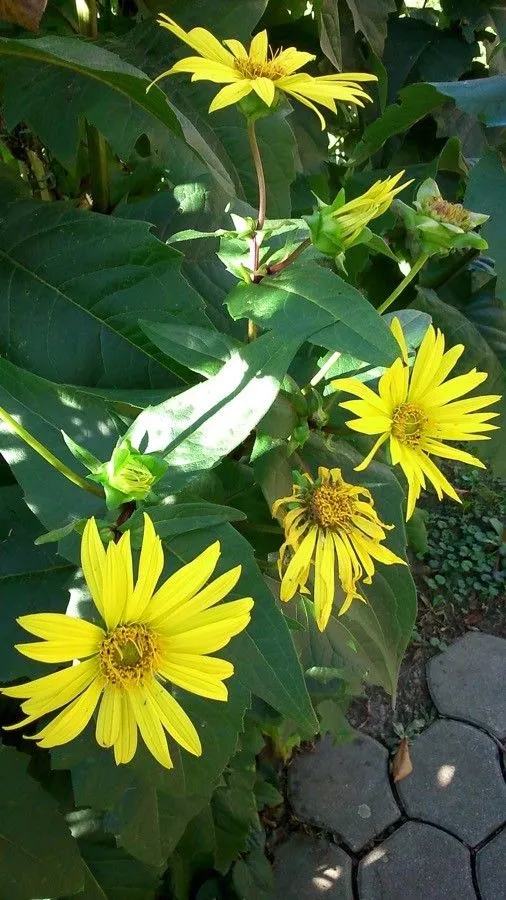
Author: L.
Bibliography: Syst. Nat. ed. 10 2: 1232 (1759)
Year: 1759
Status: accepted
Rank: species
Genus: Silphium
Vegetable: False
Observations: SE. Canada to C. & E. U.S.A.
Indian-gum, scientifically known as Silphium perfoliatum, is a remarkable perennial plant belonging to the family Asteraceae. This species hails from a vast geographical range that extends from southeastern Canada through central and eastern regions of the United States. This widespread distribution speaks volumes about its adaptability to various environmental conditions.
First documented in the seminal work “Systema Naturae” by Carl Linnaeus in its 10th edition published in 1759, Indian-gum has since been recognized for its unique botanical characteristics. Silphium perfoliatum is notable for its tall, sturdy stems, which can reach impressive heights, making it conspicuous in meadows and prairies where it naturally occurs. The plant’s leaves are large and perfoliate, meaning they wrap around the stem, a distinctive feature that aids in water collection by channeling rain down to its roots.
The bright yellow flowers of Indian-gum, arranged in composite heads typical of the Asteraceae family, attract a variety of pollinators, including bees and butterflies. This not only contributes to the plant’s propagation but also supports the surrounding ecosystem by promoting biodiversity. The flowering period spans from midsummer to early autumn, during which the plant becomes a visual spectacle and a hub of ecological activity.
Beyond its ecological benefits, Indian-gum has been historically utilized in various indigenous and traditional practices. Its robust root system makes it an excellent candidate for soil conservation and habitat restoration projects. Moreover, its ability to thrive in diverse soil types and conditions, including both wet and dry areas, underscores its potential in sustainable landscaping initiatives.
In summary, Indian-gum is a significant member of the Asteraceae family, valued not only for its striking appearance and ecological role but also for its contributions to habitat restoration and biodiversity. Its history, biology, and enduring presence across a broad range of North America underscore its importance in both natural and cultivated landscapes.
Deu: becherpflanze, durchwachsene silphie, becherpflanze, verwachsenblättrige becherpflanze
Eng: cup plant, cup-plant, cupleaf rosinweed, indian cup-plant, indian-gum, squarestem rosinweed, cup rosinweed
Ita: silfio
Dan: skålplante
Nno: haustgull
Nob: høstgull
Ces: mužák prorostlý
Swe: skålört
Hun: átnőttlevelű szilfium
Nld: zonnekroon
Fra: silphe perfolié, silphium perfolié
En: Indian-gum, Cup-plant, Indian cup-plant, Cup plant, Cupleaf rosinweed, Squarestem rosinweed, Cup rosinweed, Cupplant
Zh: 串叶松香草
Cs: Mužák prorostlý
Da: Skålplante
Nl: Zonnekroon
Fr: Silphe perfolié, Silphium perfolié
De: Verwachsenblättrige Becherpflanze, Durchwachsene Silphie, Becherpflanze, Durchwachsene Silphie, Becherpflanze
Hu: Сsészekóró, Átnőttlevelű szilfium
It: Silfio
Nb: Høstgull
Nn: Haustgull
Sk: Silfia prerastená
Sv: Skålört
Taken Jul 23, 2018 by Christophe Lo (cc-by-sa)
Taken Aug 19, 2020 by CarolinaHelena (cc-by-sa)
Taken Nov 30, 2019 by Dieter Wagner (cc-by-sa)
Taken Nov 30, 2019 by Dieter Wagner (cc-by-sa)
Taken Jul 16, 2021 by Stu Huizen (cc-by-sa)
Taken Aug 13, 2020 by Georg Lanzl (cc-by-sa)
Taken Jul 27, 2021 by MartyB (cc-by-sa)
Taken Aug 7, 2019 by will (cc-by-sa)
Taken Nov 30, 2019 by Dieter Wagner (cc-by-sa)
Taken Nov 30, 2019 by Dieter Wagner (cc-by-sa)
Taken Jul 11, 2022 by Josef Kohler (cc-by-sa)
Taken Aug 29, 2020 by Mark (cc-by-sa)
Taken Aug 5, 2022 by Kevin Fernandes (cc-by-sa)
Taken Sep 12, 2021 by Joris Moorkamp (cc-by-sa)
Taken Nov 30, 2019 by Dieter Wagner (cc-by-sa)
Taken Jul 22, 2007 by EOL − Ron Thomas (cc-by-nc-sa)
Taken Apr 20, 2022 by Jason Smith (cc-by-sa)
Taken Aug 28, 2019 by Schellmann Claudia (cc-by-sa)
Taken Jul 16, 2019 by Bastien Messey (cc-by-sa)
Taken Sep 11, 2021 by Christina P (cc-by-sa)
Taken Sep 15, 2010 by Photoflora – Benoit BOCK (©)
Taken Sep 15, 2010 by Photoflora – Benoit BOCK (©)
Taken Jul 18, 2021 by Kevin Fernandes (cc-by-sa)
Taken Apr 20, 2022 by Jason Smith (cc-by-sa)
Taken Sep 15, 2013 by Photoflora – Benoit BOCK (©)
Taken Aug 2, 2019 by martina wagner (cc-by-sa)
Taken Sep 23, 2021 by evillinn (cc-by-sa)
Taken Sep 26, 2020 by gr3uh plants (cc-by-sa)
Taken Aug 25, 2020 by Karin Walter (cc-by-sa)
Taken Sep 8, 2021 by A. (cc-by-sa)
© copyright of the Board of Trustees of the Royal Botanic Gardens, Kew.
© copyright of the Board of Trustees of the Royal Botanic Gardens, Kew.
© copyright of the Board of Trustees of the Royal Botanic Gardens, Kew.
Growth habit: Forb/herb
Growth rate: Rapid
Ph maximum: 7.5
Ph minimum: 4.5
Family: Myrtaceae Author: (F.Muell.) K.D.Hill & L.A.S.Johnson Bibliography: Telopea 6: 402 (1995) Year: 1995 Status:…
Family: Rubiaceae Author: Pierre ex A.Froehner Bibliography: Notizbl. Bot. Gart. Berlin-Dahlem 1: 237 (1897) Year:…
Family: Sapindaceae Author: Koidz. Bibliography: J. Coll. Sci. Imp. Univ. Tokyo 32(1): 38 (1911) Year:…
Family: Asteraceae Author: A.Gray Bibliography: Pacif. Railr. Rep.: 107 (1857) Year: 1857 Status: accepted Rank:…
Family: Fabaceae Author: Medik. Bibliography: Vorles. Churpfälz. Phys.-Ökon. Ges. 2: 398 (1787) Year: 1787 Status:…
Family: Aspleniaceae Author: (Cav.) Alston Bibliography: Bull. Misc. Inform. Kew 1932: 309 (1932) Year: 1932…